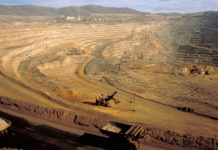
[miningmx.com] – GOLD Fields said the majority of the estimated R2.1bn in lost revenue owing to strike action would fall in the December quarter, and warned a second time that restructuring at its South African mines was imminent.
The R76bn group said some 145,000 ounces of gold production had been lost in total owing to strike action with only 19 days of a total 108 lost days at its KDC East, KDC West and Beatrix shafts falling in the September quarter, the period under review.
For the quarter, Gold Fields reported net earnings of R1.42bn from R1.6bn in the June quarter, and R2bn in the September quarter of the previous 2011 financial year. Shares in Gold Fields were marginally higher in early JSE trade.
Overall gold production for the September quarter came in at 811,000 oz, down from 862,000 oz in the June quarter. Some 35,000 oz was lost due to strike action – in which an estimated 29,000 workers participated – with a further 30,000 oz ceded owing to a fire at KDC West’s Ya Rona shaft.
Gold Fields said a forensics team was examining the possible cause of the blaze which took weeks to clear. As a result, production at Ya Rona only restarted in early November, Gold Fields said.
As a result of the production interruptions, full-year production (ended December) was expected to be no more than 3.3 million equivalent oz, Gold Fields said. This compares to a revision in August that full-year production would not exceed 3.4 million oz. Gold Fields said in July it was on course to meet full-year guidance of between 3.5 million and 3.7 million oz for the year.
In his September quarter commentary, Nick Holland, CEO of Gold Fields, reiterated an earlier warning that strike action had had an indelible effect on the South African operations, with restructuring likely.
He warned of “… the risk of significant restructuring of our South African operations in the near to medium-term” without providing details.
In notes to its September quarter review, Gold Fields said it had finished its 2012 review which had been informed by ensuring dividends had first call on cash flows, a “critical review” of declining or low margin assets and that “scarce” capital would only be spent on projects, or brownfields and greenfields projects that provided the best risk-weighted returns.
The focus would also remain on internationalising the group’s asset base while avoiding “M&A heroics” – a term used by Holland in the past. “These changes are in the process of being implemented and specific outcomes will be communicated to the market as notable changes are made,” Gold Fields said.
Commenting on the strikes, Holland said that in the main they had been caused by worker dissatisfaction with the National Union of Mineworkers.
An agreement to give early implementation to provisions in the 2011, two year wage deal would result in a 3% wage adjustment equal to a cost of R150m a year.
A separate agreement with employees at South Deep, the west Rand project that is targetting ramp-up to 700,000 oz in production by 2015, to convert to continuous operations would carry an up-front cost of R170m.
The agreement, which meant Gold Fields has withdrawn a Section 189 restructuring notice, would yield positive productivity improvements and a more sensible bonus system, Gold Fields said.
GROWTH PROJECTS
The possible restructuring and reduction in gold output from South Africa will give a much-needed boost to Gold Fields’ plans to internationalise its production base, a strategy which was knocked in the September quarter.
The group announced that its eight million ounce, Chucapaca exploration project in Peru, in which it has a 51% stake, had not met investment hurdles. Gold Fields said it would examine different mine and plant sizes for the project, and review the potential of an underground mine versus an open-pit development.
In Ghana, work on the Damang super-pit was slowed in favour of a concept study which aims to assess a smaller, but higher grade and more capital efficient operation that could be brought into production sooner.
“We are also investigating the feasibility of brownfields projects at our other mines, which are lower risk and more value accretive in the short-term than greenfields ventures,” Gold Fields said.
A feasibility study of a second plant at Tarkwa, another mine in Ghana, had also begun, Gold Fields said. This was to meet the mine’s future processing requirements in lieu of the existing heap leach operation.
“At Cerro Corona in Peru, the feasibility of a sulphide plant expansion is also being investigated,’ Gold Fields said.









